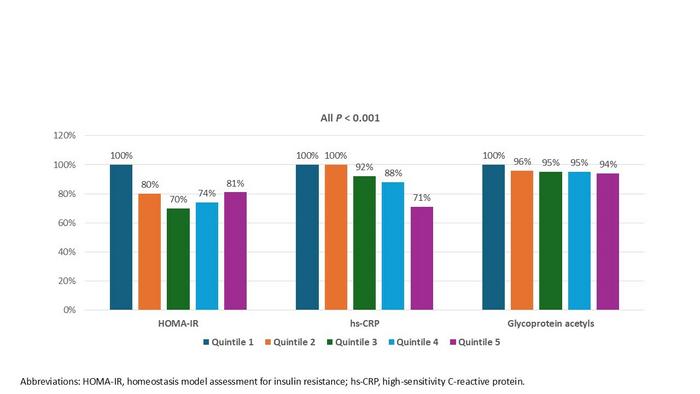Recent investigations into cardiometabolic health have shed new light on the impact of linoleic acid, a predominant omega-6 fatty acid found chiefly in seed oils and various plant foods. Moving beyond traditional dietary assessments, this groundbreaking research utilized blood biomarkers to directly measure linoleic acid levels and scrutinized their association with cardiometabolic risk factors. The findings fundamentally challenge the growing narrative that seed oils detrimentally influence cardiovascular and metabolic health, suggesting instead that linoleic acid may confer protective benefits against heart disease and type 2 diabetes.
Linoleic acid is the most widely consumed omega-6 polyunsaturated fatty acid, predominantly present in vegetable oils such as soybean and corn oil. Despite its ubiquity, the health implications of linoleic acid have recently become contentious, with certain factions asserting that seed oils exacerbate inflammatory processes and augment cardiometabolic risk. However, this new study, encompassing nearly 1,900 individuals, provides robust evidence to the contrary. By quantifying linoleic acid concentration in plasma—a reliable biomarker reflective of dietary intake—the research reveals inverse relationships between linoleic acid levels and various indicators of cardiometabolic dysfunction.
What distinguishes this study from its predecessors is the emphasis on objective biochemical markers rather than self-reported dietary intake methods, which are often plagued by recall bias and imprecision. The comprehensive biomarker panel included measures of glucose, insulin, insulin resistance (assessed via the homeostasis model assessment of insulin resistance, or HOMA-IR), and inflammatory proteins such as high-sensitivity C-reactive protein (hs-CRP), glycoprotein acetyls, and serum amyloid A. Collectively, these biomarkers paint a detailed physiological portrait of cardiometabolic status, enabling a nuanced understanding of linoleic acid’s potential mechanistic effects.
Consistently, participants stratified into higher linoleic acid quartiles exhibited significantly reduced fasting glucose and insulin levels, suggesting improved glycemic control and enhanced insulin sensitivity. This relationship translated into lower HOMA-IR scores, indicating diminished insulin resistance—a central pathological feature in the progression to type 2 diabetes. Concurrently, markers of systemic inflammation, which are implicated in atherosclerotic cardiovascular disease pathogenesis, were markedly lower in individuals with elevated linoleic acid. These results underpin the hypothesis that linoleic acid may modulate inflammatory pathways and glucose metabolism, converging to mitigate cardiometabolic risk.
The cross-sectional design of the research leveraged data derived from a cohort initially established to investigate Covid-19 outcomes. Nevertheless, the breadth of available biochemical data and the large sample size fortify the statistical power and generalizability of the findings. Importantly, the use of plasma linoleic acid concentrations circumvents methodological limitations inherent to dietary questionnaires, affirming that observed correlations genuinely reflect biological exposure rather than reporting artifacts.
Kevin C. Maki, Ph.D., an adjunct professor at Indiana University School of Public Health-Bloomington and chief scientist at Midwest Biomedical Research, emphasized the consistency observed across measured biomarkers. Dr. Maki highlighted that individuals with higher circulating linoleic acid attained a more favorable cardiometabolic risk profile. Such data stand in contrast to prior conjectures implicating omega-6 polyunsaturated fats in heightened inflammation and metabolic disturbances, underscoring the necessity to revisit dietary guidelines and public perceptions regarding seed oils.
This evidence also aligns with epidemiological investigations demonstrating that linoleic acid intake correlates with reduced incidence rates of cardiovascular events—such as myocardial infarction and stroke—and type 2 diabetes across diverse populations. While many of these studies relied on self-reported diet, the biomarker-based approach utilized here corroborates their findings with greater precision and biological plausibility. The data collectively suggest that linoleic acid exerts beneficial physiological effects that extend beyond mere nutrient consumption patterns.
Despite these promising findings, Dr. Maki and colleagues advocate for further intervention trials to validate causality and to determine whether dietary modulation of linoleic acid intake can tangibly reduce the occurrence of adverse cardiometabolic outcomes. Understanding the specific dose-response relationships and potential effect modification by individual genetic or metabolic profiles will be critical in translating these results into practical public health recommendations.
Future research directions include comparative analyses of different oil sources, particularly contrasting those with varying fatty acid compositions, to elucidate the precise impact of distinct lipid profiles on inflammation and insulin regulation. Such studies could refine nutritional guidance regarding optimal fat consumption, balancing the roles of omega-6 and omega-3 fatty acids in promoting metabolic health and preventing chronic disease.
At the upcoming NUTRITION 2025 meeting, Dr. Maki is slated to present these novel insights in dedicated sessions scrutinizing bioactive dietary components and their influence on inflammation, glucose homeostasis, and bone metabolism. The dissemination of these data at a premier international forum reserves the potential to shift scientific consensus and encourage further multidisciplinary collaboration.
It is important to note that while these abstracts were rigorously selected by expert committees, the findings have yet to undergo the extensive peer-review process customary for scientific publication. Thus, these promising insights remain preliminary, warranting cautious interpretation until corroborated by additional research and formally published.
The American Society for Nutrition (ASN), as the preeminent global organization supporting nutrition research and education, provides a pivotal platform for such cutting-edge discoveries. The continuation of scientific inquiry into the nuanced effects of dietary fatty acids like linoleic acid is essential for advancing evidence-based nutritional policy and enhancing population health outcomes worldwide.
In conclusion, this emerging body of work compellingly challenges existing skepticism surrounding seed oils and their omega-6 fatty acid content. By leveraging objective biomarkers and a comprehensive assessment of cardiometabolic risk factors, the study accentuates linoleic acid’s association with healthier metabolic profiles, reduced inflammation, and improved insulin sensitivity. These revelations not only refine our biochemical understanding but also stimulate reconsideration of dietary fat recommendations, underscoring the complexity of nutritional science and its evolving landscape.
Subject of Research: Linoleic acid levels and their association with cardiometabolic risk factors.
Article Title: New biomarker-based evidence suggests linoleic acid may reduce cardiometabolic risk.
News Publication Date: Not specified.
Web References:
Image Credits: Carol F. Kirkpatrick and Kevin C. Maki
Keywords: Cardiometabolic health, linoleic acid, omega-6 fatty acids, insulin resistance, inflammation, hs-CRP, HOMA-IR, seed oils, type 2 diabetes, cardiovascular disease, plasma biomarkers, nutritional biochemistry




